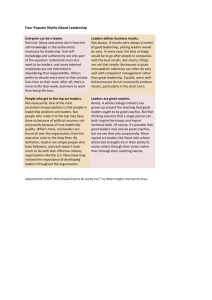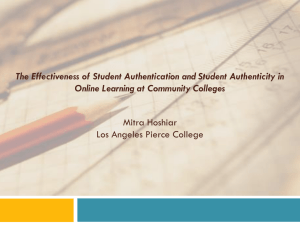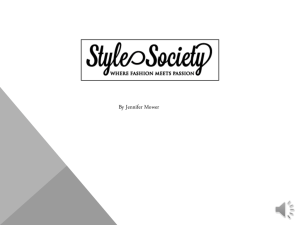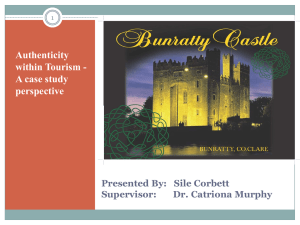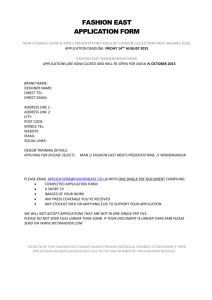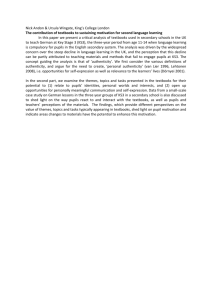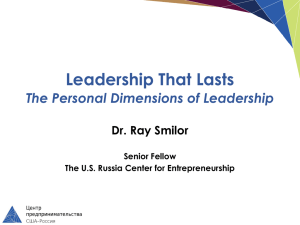Thesis
advertisement
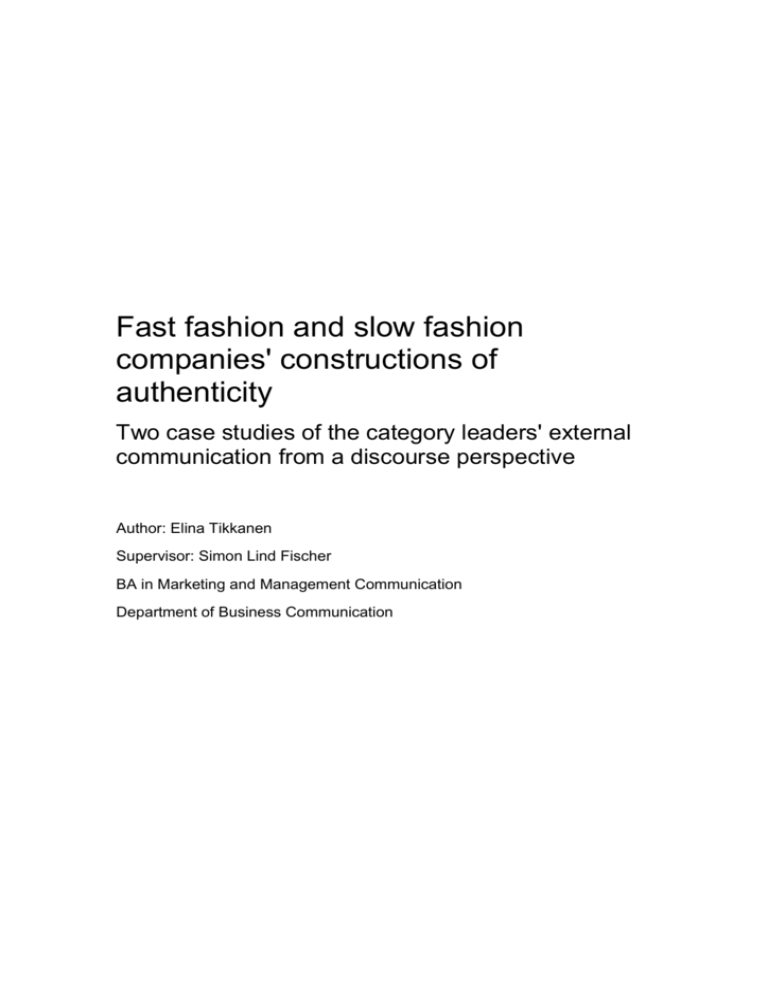
Fast fashion and slow fashion companies' constructions of authenticity Two case studies of the category leaders' external communication from a discourse perspective Author: Elina Tikkanen Supervisor: Simon Lind Fischer BA in Marketing and Management Communication Department of Business Communication Bachelor’s Thesis – BA MMC – 402885 Summary As the demand for authenticity is documented to be increasingly central in the postmodern societies, the report seeks to investigate how contemporary fast fashion and slow fashion companies respond to this demand. As the research functions as a preliminary research of the topic, it approaches the question through a qualitative case study method. It examines the leading Swedish fast fashion and slow fashion companies’, H&M and Filippa K, external communication, conducting discourse analyses of 8 press releases issued as part of the companies’ characteristic marketing initiatives. To approach the contemporary phenomenon of authenticity, a social constructionist perspective is assumed. The perspective is reflected by the chosen theories, which build upon a premise of constructive authenticity. Grayson and Martinec’s conceptions of indexical and iconic authenticity, together with Beverland et al.’s account of moral authenticity, provide the research with an initial theoretical framework. In addition, to provide direction to the analysis, a review of previously encountered attributes of authenticity is conducted, resulting in a guiding list of the potential conceptual and manifest expressions of authenticity. The results show that both companies use various disparate cues to convey authentic images, applying both conceptual and manifest expressions. In addition, moral authenticity is equally dominant in their respective lines of communication. However, the companies’ uses of indexical and iconic cues differ significantly: While H&M applies primarily iconic cues, Filippa K’s cues are mostly indexical. Moreover, contradicting previous assertions, the results indicate that moral authenticity need not be conveyed merely through iconic cues, but that indexical cues may work equally well. Finally, basing on the previous research, the report suggests that suitability of certain expressions may be influenced by the field of industry and the level of company’s prestige. While the results do not allow generalizations, they may function as inspiration for other fashion marketers. In addition, the represented suggestions may stimulate 2 Bachelor’s Thesis – BA MMC – 402885 further research, indicating particularly worthwhile questions in the fields of fashion and authenticity. 3 Bachelor’s Thesis – BA MMC – 402885 Table of Contents 1. INTRODUCTION 5 1.1 APPETIZER 1.2 PROBLEM STATEMENT 1.3 METHODOLOGY 1.3.1 SOCIAL CONSTRUCTIVISM 1.3.2 THEORETICAL FRAMEWORK 1.3.3 STRUCTURE 5 7 7 7 8 10 2. LITERATURE REVIEW 10 2.1 AUTHENTICITY 2.1.1 AUTHENTICITY AND POSTMODERNISM 2.1.2 RESEARCH ON AUTHENTICITY 2.1.3 CONCEPTIONS OF AUTHENTICITY 2.1.4 EXPRESSIONS OF AUTHENTICITY 2.2 TWO BRANCHES OF FASHION: FAST FASHION AND SLOW FASHION 10 10 11 12 15 17 3. INTRODUCTION TO CASE COMPANIES 18 3.1 H&M 3.2 FILIPPA K 19 19 4. METHOD 20 4.1 SINGULAR CASE STUDY METHOD 4.2 PRIMARY DATA 4.3 CRITICAL DISCOURSE ANALYSIS 20 20 21 5. RESULTS 22 5.1 MORAL AUTHENTICITY 5.1.1 H&M: NON-COMMERCIALITY, CONNECTION TO ARTISTS 5.1.2 FILIPPA K: NON-COMMERCIALITY, CONNECTION TO SOCIAL CAUSES, ARTISTIC INTENTS 5.2 ICONIC AUTHENTICITY 5.2.1 H&M: FREEDOM, ORIGINALITY, STYLISTIC CONSISTENCY 5.2.2 FILIPPA K: HISTORY 5.3 INDEXICAL AUTHENTICITY 5.3.1 H&M: GENUINENESS 5.3.2 FILIPPA K: GENUINENESS, ORIGINALITY, STYLISTIC CONSISTENCY, QUALITY COMMITMENT 23 23 25 27 27 28 28 28 29 6. DISCUSSION 30 7. CONCLUSION 32 8. LIMITATIONS AND FUTURE RESEARCH 33 REFERENCES 33 APPENDICES ERROR! BOOKMARK NOT DEFINED. Total number of characters: 54 878 4 Bachelor’s Thesis – BA MMC – 402885 1. Introduction 1.1 Appetizer Many marketing experts today tell that being authentic is one of the most significant cornerstones of contemporary marketing (Crawford 2009; Bai, Tan, Choi & Au 2009; Beverland 2005). In the same vein, the tension between authenticity and inauthenticity (or imitation) is said to be a key constituent of our contemporary Western culture (Grayson & Martinec 2004). The need for authenticity is so substantial that books and companies exist to tell brand managers how to be (or at least seem) authentic (Crawford 2009). Despite its strong connection with today’s marketing practice and “all the attempts to fake it as a marketing ploy” (Dolliver 2001: 19, in Grayson & Martinec 2004), authenticity has proved to be a longstanding and persistent theme, not only in marketing, but also in other disciplines like anthropology, geography, communication studies, philosophy and sociology (Grayson & Martinec 2004). The persistent position of authenticity has made it an important positioning device for many contemporary brands. When positioning oneself as authentic, one does not only make a claim about oneself, but simultaneously, may position the competition as less trustworthy, less reputable and less knowledgeable. In addition, “authenticity has significant value in separating a brand from others in a similar category and attracting the attention of consumers who are on a quest for individuality” (Bai et al. 2009: 254). Marketers’ inclination toward authenticity is predominantly driven by the contemporary postmodern consumer culture. This new “cultural logic” or “state of mind” – as the condition has been called (Featherstone 1988: 198-199) – is centred around individuals’ identity construction projects, which are realized through constant consumption. As consumption serves the projects largely through authentic market offerings (Beverland, Lindgreen & Vink 2008; Turunen & Laaksonen 2011), marketers’ task is to construct perceptions of such. Although the concept of authenticity has intrigued authors from various fields, the definitions of it are relatively inconsistent (Grayson & Martinec 2004). The conception is further complicated by industrial factors, since what is perceived as 5 Bachelor’s Thesis – BA MMC – 402885 authentic in one industry, may not be regarded as such in the other. Although most of the findings are claimed to be transferrable to other industries, the actual market manifestations of authenticity are not well understood in a number of industrial realms (ibid.). To contribute to the lack of comprehension, this report will investigate the concept as related to fashion industry. The industry is especially prone to the impacts of authenticity/inauthenticity perceptions, as it provides individuals with highly conspicuous resources for identity constructions. Furthermore, the recent development and polarization of the two branches of the industry – fast fashion and slow fashion – have added to the tension between authenticity and inauthenicity, providing the research with a highly actual sphere of study. The new entrant of the industry, fast fashion – also called as “throwaway” fashion (Bhardwaj & Fairhurst 2010: 166), is characterized as low-priced and lower quality, but highly up-to-date fashion, exemplified by ZARA, H&M and many other, especially European companies (To et al. 2010). Providing cheap copies of catwalk designs and matching to everchanging consumer tastes, the branch seems to advocate inauthenticity. Slow fashion, on the other hand, refers to more traditional, higher-priced and higher quality fashion that relies on more consistent styles and seasonal fashion cycles (Hines and Bruce 2007). While slow fashion does not champion inauthenticity as clearly as its counterpart, both branches need to generate authenticity perceptions in consumers’ minds, to be able to compete at the market place (Gustafsson 2006). Given that marketers’ task is to construct perceptions of authenticity, this report seeks to investigate how fashion marketers can successfully construct such perceptions. Although authenticity has gained broad attention among consumer researchers, this study explores the concept from the company’s point of view, providing exemplars of contemporary companies’ manifestations of it. To illuminate how authenticity is successfully conceived and communicated by fast fashion and slow fashion companies, discourse analyses of the category leaders’ external communication will be carried out, focusing on the following problem statement. 6 Bachelor’s Thesis – BA MMC – 402885 1.2 Problem statement From a discourse perspective, how do market leaders of the two categories of fashion companies – fast fashion and slow fashion companies, respectively – communicate authenticity in their external communication? 1.3 Methodology In an attempt to research the question, the report assumes a social constructionist perspective, which is largely consistent with the postmodern mindset and therefore applicable to such a postmodern phenomenon as the notion of authenticity is (Burr 2001). In accordance with the chosen perspective, the study applies the method of discourse analysis, through which it seeks to examine constructions of authenticity in the companies’ external communication. 1.3.1 Social constructivism Adhering to Burr’s (2001) inspection, the social constructivist perspective implies that the research will be conducted from the following presumptions: 1) The study assumes a critical stand towards taken-for-granted knowledge, challenging the positivist view based on objective observations and tendency toward generalizations. Instead, it considers world as consisting of artificial categorizations constructed by human’s inherently selective perception, due to which the generated knowledge is based on subjective experience and cannot be generalized. 2) The study assumes also a relativist position, according to which the ways to understand the world are dependent on the context, such as one’s cultural and historical background. 3) Finally, the study regards knowledge as constructed in social processes between people. Thus, what is seen as ‘truth’ is a product of social processes and everyday interactions in which people are constantly engaged with each other. When the ‘truth’ is acted upon, it is reproduced and affirmed. The chosen constructionist perspective has fundamental implications in the conduct of this study. Ontologically it means that the report regards world as constructed in language, in social practices between participants. Thereby, authenticity is regarded as constructed in text, in the companies’ external communication. Epistemologically the perspective implies that knowledge is gained by investigating how participants of 7 Bachelor’s Thesis – BA MMC – 402885 a certain social practice actively contribute to the construction of meaning. Thus, the notion of authenticity is investigated by analyzing how the companies actively construct meanings of it, and how other actors influence the process. Finally, the social constructionist stand suggests that the active constructions be best examined by analyzing the occurring discourses. The method of discourse analysis serves as a means to identify the active and passive discourses, revealing the aspects that are actively foregrounded and backgrounded in a text (e.g. van Dijk 1995). Hence, the method is used to discover the foregrounded aspects of authenticity, providing indication of how fashion companies conceptualize and manifest the concept. As the mentioned subjectivity and relativism imply, the purpose of this study is not to aim at generalizations through quantitative measures, but to apply qualitative approach and explain parts of the phenomenon by answering the “how” question through exemplars of fashion companies. While the position does not provide marketers with models for use, it helps them to comprehend the phenomenon and may inspire in the creation of their own, well-informed and grounded efforts to communicate authenticity. 1.3.2 Theoretical framework To investigate how fast fashion and slow fashion companies communicate authenticity, the study will heavily draw from previous studies and conceptions of the concept. In addition, it will provide an overview of the postmodern consumer culture and a brief account of fast fashion and slow fashion strategies, developing a context for the final analysis. To review the concept of authenticity, Wang’s (1999) notion of constructive authenticity provides the study with a point of departure. Building on the notion, two major lines of study, one that attempts to conceptualize the different types of authenticity and the other that seeks to identify specific attributes of it, are accounted. As the former line of work is determinately characterized by two types of authenticity, one relating to real, substantiated authenticity and the other relating to imagined, look-alike images, the study adopts this dichotomy as a foundational way to comprehend the concept. Grayson and Martinec’s (2004) account of indexical and 8 Bachelor’s Thesis – BA MMC – 402885 iconic authenticity will serve as an explanatory theory to the dichotomy, as it is rudimentary in nature and thus one of the most often elaborated accounts in the literature. To further elaborate the dichotomy’s manifestations in the marketplace, Beverland and Luxton’s (2005) notions of IMC and decoupling approaches will provide relevant outlooks. Finally, the dichotomy is transformed into a trichotomy by including Beverland et al.’s (2008) notion of moral authenticity as a third type of authenticity. As the authors build their research upon Grayson and Martinec’s concepts of indexical and iconic cues, moral authenticity does not contradict the developed categories, but serves as yet another type of authenticity in which moral aspect is at the front. The other line of study – the one that seeks to identify various properties of authenticity – serves the research with specific attributes, against which the discourses can be analyzed. A gathered list of the encountered expressions seeks to direct the analyzer’s selective perception, introducing some objectivity to the otherwise subjective process. Bai et al.’s (2009) account of various attributes of authenticity acts as the main contribution to the list, as it draws from the researchers’ literature review. However, Beverland’s (2006) and Beverland and Luxton’s (2005) studies and Holt’s (2003) theorization strongly suggest three additional attributes, due to which these properties are included as complementary aspects. Although the attributes are not directly identified as related to fashion, they provide the analysis with a framework of potential properties that may occur in the communication of the fashion companies. While the research is mainly built upon the given theorizations of authenticity, brief overviews of postmodernism and the emerged categories of fashion will create the context for the analysis. The review of postmodernism will draw from the theories of Featherstone (1988) and Brown (1993), who have extensively contributed to the literature on the topic. Fast fashion and slow fashion, on the other hand, are explained in accordance with the conceptions of the fashion-marketing specialists, Hines and Bruce (2007). 9 Bachelor’s Thesis – BA MMC – 402885 1.3.3 Structure The report will proceed by first reviewing literature on the related fields. Theories of postmodernism, authenticity and the two branches of fashion are accounted. Then, the case companies are represented and the applied method and the investigated primary data introduced in more detail. After this, results of the analysis will follow, leading to discussion, conclusion and suggestions for future research. 2. Literature review 2.1 Authenticity Literature review on authenticity shows that the concept has evoked interest in various fields, intriguing the academic mind since the end of the eighteenth century (Bai et al. 2009). However, only in the past decades this “powerful moral ideal” has become one of the most debated topics both at the marketplace and in the marketing literature (249). The significant rise of authenticity is often attributed to the rise of the new postmodern consumer culture (e.g. Bai et al. 2009). Therefore, before taking a closer look at the conceptions of authenticity, the contemporary postmodern condition serves some attention. 2.1.1 Authenticity and postmodernism The postmodern condition, also described as a “cultural logic” or contemporary “mind-set” (Featherstone 1988), was born in the 1960s as a counter-reaction to modernism. Although regarded as an ambiguous concept (Brown 1993), postmodernism has influenced a board range of artistic, intellectual and academic fields, ranging from music, art, architecture and literature to history, philosophy, anthropology, sociology, economy, and not least, marketing (ibid.). Postmodenism’s impact on marketing is especially noteworthy, as the urge to consume is seen as “a characteristic symptom, maybe the characteristic symptom, of the postmodern condition” (Brown 1993: 19). This consumption-centred consumer culture is characterized by retro-orientation, increasing consumer power, fragmentation, individuality, self-expression and stylistic self-consciousness (Brown 10 Bachelor’s Thesis – BA MMC – 402885 1993; Featherstone 1988). Although the prominent position of authenticity can be regarded as a postmodern feature in its own right (Bai et al 2009), it can be also thought of as a reflection of other postmodern features. For example, retroorientation – preference for past over future and tried-and-tested over new-andimproved (Brown 1999) – is reflected in authenticity’s inclination to past, while increasing consumer power is reflected in companies’ attempts to appear authentic through interactive and transparent customer-focused marketing strategies (Bai et al. 2009). As authenticity seems to reflect the demands of today’s consumer culture, according to some, it has become a minimum requirement for contemporary brands (Gustafsson 2006). The notion that authenticity and postmodern condition are intertwined suggests that the conception of authenticity is tightly bound to a certain time and culture. As a result, authenticity has no consistent, all-inclusive meaning, but rather a diverse set of conceptions that emphasise its various facets. In the following, the report will review some of the most prominent theories and accounts of the concept, which will later direct the analysis. 2.1.2 Research on authenticity Literature review on marketing-based authenticity discovers that the concept has been researched in several fields using a variety of approaches. The concept has been studied in connection to fields such as tourism (Cole 2007), theme parks (Grayson & Martinec 2004), luxury wines (Beverland 2006), artistic collaborations (Bai et al. 2009) and advertising (Beverland 2008). While most of the studies have adopted either a consumer perspective or a producer perspective, examining how consumers view authenticity (e.g. Martinec & Grayson 2004) or how the concept is applied in practice (e.g. Beverland & Luxton 2005), some have involved perspectives of other stakeholders (e.g. Cole 2007). Moreover, the studies have assumed distinctive goals, as some have attempted to identify attributes of authenticity (Bai et al. 2009; Beverland 2006), some represent inquires about the essence of the term (e.g. Ingram 2007; Gustafsson 2006) and some categorize different forms of it (e.g. Beverland 2008; Grayson & Martinec 2004). 11 Bachelor’s Thesis – BA MMC – 402885 Consequently, the definitions of authenticity are as various as are the approaches. Despite marketers’ overwhelming interest in authenticity, one of the most comprehensive definitions comes from sociology, describing authenticity as "sincere, innocent, original, genuine, and unaffected, distinct from strategic and pragmatic self-presentation … linked to moral authority of the creator and simultaneously to the fact that the object was made by hand, not mechanically produced … [with an] absence of cognitive understanding, creating an unmediated experience" (Fine 2003, in Beverland & Luxton 2005: 103). As the definition is found to be consistent with a number of proposed attributes of marketing-based authenticity (ibid.), it will serve as an enlightening point of departure for subsequent accounts. Before proceeding to the central theories of authenticity, a bottom line clarification of how this report understands the concept needs to be done. Wang (1999) differentiates between three types of authenticity: constructive authenticity meaning that something can acquire authenticity through social recognition, objective authenticity referring to a museum version, and existential authenticity indicating a special existential state in which individuals are true to themselves. This report, like most of the previous studies, views authenticity as conforming to the first type, constructive authenticity. Thus, it regards authenticity as a social construct that needs a social context and an interpreter to exist (Grayson & Martinec 2004; Turunen & Laaksonen 2011). Accordingly, the concept has no objective quality, but is negotiable and dependent on the observer’s perception (Cole 2007). In the following sections, the report will account different views of authenticity, as reflected by the literature reviewed. Firstly, it will represent accounts of different ways to comprehend the concept, after which the attention will be turned to specific properties that are suggestive of authenticity. 2.1.3 Conceptions of authenticity The socially constructed nature of commercial authenticity has raised a debate concerning the essence of the concept and the related ethical concerns, evolving around whether authenticity can and should be a mere surface construction or whether substance is needed to backup such constructions. Centring the debate, 12 Bachelor’s Thesis – BA MMC – 402885 there are two types of authenticity: one that refers to the real, original or genuine with a substance, and the other that refers to the accepted but enjoyed look-alike images. Respectively, these types have been referred to as cool and hot authenticity (Selwyn 1996), post postmodern and postmodern authenticity (Holt 2002, 2003), pure and approximate authenticity (Beverland et al. 2008), and indexical and iconic authenticity (Grayson & Martinec 2004). In addition, Beverland and Luxton’s (2005) dichotomy between integrated marketing communication (IMC) approach and decoupling approach can be accounted representing the conception. 2.1.3.1 Indexical and iconic authenticity To review the chief idea behind the polarization, Grayson and Martinec’s (2004) account on indexical and iconic authenticity serves as a good point of departure. As the theory is built upon the philosopher Charles Peirce’s account on the theory of signs, it has provided a fruitful base for several subsequent studies, laying a framework upon which new elaborated theories have been constructed. Due to the foundational nature of this account, the terminology of indexical-iconic dichotomy will be adopted also for the purposes of this paper. The authors provide an account of “real” and “imagined” aspects of authenticity, constructing the concepts upon Peirce’s notions of indexical and iconic cues. They regard indexical cues as physically or psychically linked to the entities they are attributed. This means that the cue or action needs to have “a factual and spatiotemporal link” to something else to connote authenticity (298). Accordingly, indexical authenticity is used to describe something that is thought not to be a copy or imitation, but “the original” and “the real thing” (297). Similarly, a company’s actions are authentic if they are thought to reflect the essence of the company and are not imitated to meet social conventions or make money. Iconic cues, on the other hand, are said to refer to the cues that make something resemble something else that is indexically authentic. Physical or psychic links are not needed, as the observer is able to assess the level of similarity by comparing the imitation to pre-existing knowledge or to a mere idea of how something ought to be. Despite that some things are perceived as having more indexical or iconic authenticity than others, authors maintain that every perceived 13 Bachelor’s Thesis – BA MMC – 402885 cue has both iconic and indexical properties. Thus, these two are not mutually exclusive, but the distinction is created through humans’ selective perception. To further elaborate how the two types of authenticity take place at the marketplace, Beverland and Luxton’s (2005) notions of IMC and decoupling approaches provide a perspectivating outlook. In their study, the authors distinguish between two general approaches to communication of authenticity: integrated marketing communication (IMC) approach and decoupling approach. By IMC approach they refer to a strategy that is based upon an idea of transparency and consistency of internal and external communication. Due to this, the company’s (in)authentic façade necessarily reflects its actual behind-the-scenes operations, which means that the projected authenticity is indexical in nature. The decoupling approach, on the other hand, is declared to suggest that the company’s behind-thescenes operations be “far more tightly programmed and scripted than consumers are aware of” (104). For instance, when the company seeks to grow by reorganizing its backstage operations, the brand veneer is kept unchanged, communicating the sustained unprofessional image built around authenticity. The strategy parallels the idea of iconicity, as the distinct brand veneer serves as an icon of the indexically authentic company, while no real connection to such exist. According to Beverland and Luxton, many companies, especially niche brands facing large mass-market competition, would benefit from the strategy, as it allows them both to deliver their brand promises of personalized authentic market offerings and to grow to ensure their relevance. 2.1.3.2 Moral authenticity Finally, to expand on the developed dichotomy between indexiality and iconicity, Beverland et al.’s (2008) intriguing notion of moral authenticity will serve as a third type of authenticity. Building upon Grayson and Martinec’s indexical and iconic authenticity, the authors identify pure and approximate authenticity, representing the respective original categories. However, their research discovers yet another type of authenticity, moral authenticity, which is strongly linked to a sense of moral purpose and individually held values. Although the authors claim that moral authenticity is most often attributed to iconic cues, it differs from iconic authenticity 14 Bachelor’s Thesis – BA MMC – 402885 in its disposition to genuineness of intent, “be it evidenced by real commitments to social programs or through the love of craft” (Beverland et al. 2008: 12). So far, the literature review has developed a foundation for understanding different types of authenticity: indexical authenticity, iconic authenticity and moral authenticity. In the following, the report will turn to review specific expressions of authenticity as reflected by the literature. 2.1.4 Expressions of authenticity Most of the authors agree that rather than stating, ‘we are authentic’, companies should provide consumers with cues which suggest authenticity (e.g. Beverland et al. 2008). For instance, Grayson and Martinec (2004) maintain that “the cues for communicating and perceiving authenticity are at the foundation of this dialogue between marketers and consumers over what is (or is not) authentic, and understanding and specifying these cues is an important step in the process of understanding this negotiation of meaning” (310). In order to respond to the broad demand for authenticity, marketers should not consider the different expressions as rivals, but continually draft together various disparate cues of authenticity in order to create rich brand meanings for a board range of consumers (Beverland 2005). Moreover, the attributes need to be constantly adapted and updated, so as to respond to the “interplay between creators, commercial interests, critics, competitors, and consumers” (Beverland & Luxton 2005: 104). Although the literature review did not discover accounts of authenticity as purely related to fashion, the notion that many attributes are transferrable to other industries lets us consider the encountered attributes as potential expressions of authenticity also in the fashion context (Beverland 2006). Bai et al.’s (2009) account of expressions of authenticity – as presented in their study of Adidas’s artistic collaborations – is one of the most comprehensive overviews encountered. Although Bai et al.’s study examines the construction of authenticity with reference to artists, their findings are widely supported. Moreover, the findings’ strong delineation to the artistic domain is justified by the notion that “authenticity is a central defining feature of the artistic domain” (Bai et al. 2009: 253), due to 15 Bachelor’s Thesis – BA MMC – 402885 which artistic properties could construct authenticity also in other industrial domains. Drawing from a literature review, authors understand authenticity in terms of its conceptual expressions and manifest expressions, where the former represents the abstract dimensions of authenticity, and the latter, consisting of both visual and nonvisual properties, its incarnate forms. Because the conceptual and manifest forms exist at different existential levels, the categories share similar meanings. However, communicating authenticity at different levels is recognized as an important means to convey the impression to a heterogeneous range of consumers. Bai et al.’s complete list of authenticity expressions is as follows: Conceptual expressions – abstract dimension: Originality Self-expression/self-realization (being true to oneself) Genuineness/sincerity/actuality Freedom Exclusivity/uniqueness Non-commerciality/innocence Manifest expressions – incarnate forms: Hand-crafting History Place Creative process/method of production Link between the final design and the creative process A connection to a particular person or organization (e.g. via endorser’s narration, reputation, experience or signature) Limited edition Several authors support Bai et al.’s findings. For instance, Beverland (2006) and Beverland and Luxton (2005) identify downplaying commercial considerations and a 16 Bachelor’s Thesis – BA MMC – 402885 sincere brand story as important factors of authenticity among fine and luxury wineries. Sincerity and actuality are endorsed also by Crawford (2009), while Beverland et al. (2008) conclude that exclusiveness and self-expression may be suggestive attributes of authenticity. Holt (1998), on the other hand, relates authenticity to artisanal goods and small hand-crafted production runs, while Beverland et al. (2008) find out that craftsmanship, small batch production methods, links to history and tradition, place of production and connection to the creator indicate authenticity. Likewise, Beverland’s (2006) study among luxury wineries identifies method of production, history and place as important factors of authenticity. To complement Bai et al.’s findings, three additional expressions, implied by Beverland (2006), Beverland and Luxton (2005) and Holt (2003), deserve to become considered in their own right: Reference to (sub)culture Stylistic consistency Quality commitments While the two first are classified as manifest forms of authenticity, the latter is determined to represent the abstract dimension. A review of all the encountered properties of authenticity is presented in Table 1 (App. 1). As the framework for authenticity is now complete, the report turns to review the concepts of fast fashion and slow fashion, creating context for the analysis. 2.2 Two branches of fashion: fast fashion and slow fashion Along with the rise of the contemporary postmodern consumer culture, the fashion industry has seen a rise of a fast fashion phenomenon. Although the phenomenon is not new, its roots being tracked back to the development of quick response techniques in the late 1970’s, the term has come to a common usage only during the last decade (Hines & Bruce 2007: 40). The rise of the phenomenon has been driven by a combination of contemporary factors, including increasing consumers’ fashion savviness, tendency to look to celebrities as style advisers, and increasing fashion 17 Bachelor’s Thesis – BA MMC – 402885 coverage in the media (Barnes & Gaynor 2010). Fast fashion, also called as “throwaway” fashion (Bhardwaj & Fairhurst 2010), describes a retail strategy of adapting merchandise assortment to current and emerging trends as quickly and effectively as possible. The main objective of this strategy is to reduce demand uncertainty by producing short-cycle fashion products close to and during the selling season (Hines & Bruce 2007). While “slow fashion” industry (Cohen 2011: 13) – the name given to the traditional fashion industry to counterpose the fast fashion phenomenon – relies on early fashion forecasts and twice-a-year introductions of the new seasonal styles, fast fashion companies forecast much closer to season and refresh their collections on monthly, or even weekly basis, based on actual consumer demand (Hines and Bruce 2007). While fast fashion has been embraced as “one of the most effective strategies to compete with the speedy change in the industry” (To et al. 2010: 473) and as a strategy of “democratizing couture and bringing trendy, affordable items to the masses” (Sull & Turconi 2008: 5), it is also said to be centred around inexpensive, cheaply made designer knockoffs that go in and out of style faster than traditional fashion. Furthermore, fast fashion business is often viewed as not as socially or ecologically responsible as slow fashion business, which is regarded as well-made, long-lasting, free of sweatshop labour, and capable of being appreciated for longer than a few weeks (Cohen 2011). Now, as the concepts of fast fashion and slow fashion are clarified, introductions to case companies will follow. 3. Introduction to case companies H&M and Filippa K were chosen to represent the leaders of fast fashion and slow fashion categories, respectively. The factors contributing to the selection of these particular companies included their common country of origin (Sweden), international operation base, international and homeland success, common corporate language (English), and availability of press material. The criteria of common country of origin and international operation base were determined to 18 Bachelor’s Thesis – BA MMC – 402885 eliminate the major cultural influences. Common corporate language and availability of material, on the other hand, facilitated the analyses, while the criterion of successfulness sought to ensure the findings’ meaningfulness and relevance as inspiration for others. 3.1 H&M H&M Hennes & Mauritz AB (H&M) is a Sweden-based fast fashion company, established in 1947. The company has operated internationally since 1964 and by 2012 it had around 2500 stores spread across 44 markets. H&M’s business concept is to give the customer unbeatable value by offering the latest fashion and quality at the best price. From 2004, as part of its strategy, the company has initiated designer collaborations with names such as Karl Lagerfeld, Stella McCartney, Viktor & Rolf, Roberto Cavalli, Comme des Garçons, Matthew Williamson, Jimmy Choo, Sonia Rykiel, Lanvin and Marni. The annual collaborations have become the company’s trademark, and the several press releases issued on each project generate extensive media coverage. Although H&M Hennes & Mauritz AB now sells clothes under several brands like COS, Monki and Cheap Monday, this study focuses on its H&M corporate brand. (Facts about H&M) 3.2 Filippa K Filippa K is a Sweden-based slow fashion company, established in 1993. It has operated internationally from 1994, and is now present in over 20 markets all over the world. The company’s business idea is to “design, manufacture, communicate and sell commercial fashion garments and accessories with its own, timeless style” (About). It positions itself as a leader in modern minimalism, high quality and longlasting wearable design (The Story), whose philosophy is based on the concepts of style, simplicity and quality (About). In 2008, Filippa K opened its first Filippa K Second Hand Store in Stockholm, Sweden. The store functions on commission basis, people being able to both sell and buy old Filippa K clothes and accessories at the store. The initiative was reported through several press releases and it obtained publicity as a distinctive CSR activity (e.g. Fashion & Beauty 2008). 19 Bachelor’s Thesis – BA MMC – 402885 4. Method 4.1 Singular case study method In an attempt to examine how the leaders of fast fashion and slow fashion categories communicate authenticity, singular case studies of H&M’s and Filippa K’s communication were carried out. The case study research method is said to be appropriate for investigating contemporary phenomena within their real-life context, when the boundaries between phenomenon and context are not clearly evident (Yin 1984). Like already seen, the notion of authenticity qualifies as such case, being both contemporary and dependent on the context. Then again, singular case studies, where only one case is thoroughly surveyed, are claimed to be appropriate in the occasions where the research is conducted as preliminary research (Yin 1989, in Bai et al. 2009). Because no prior research investigating authenticity among fast fashion and slow fashion companies was encountered in the secondary research, the topic qualifies as such occasion. 4.2 Primary data Basing on the given secondary data, i.e. the literature reviewed, the case studies were carried out by analyzing the category leaders’ external communicative material. The primary data consisted of the companies’ press releases issued as part of their unconventional marketing strategies: H&M’s press releases concerned the newest designer collaboration with Marni, while Filippa K’s releases were related to the opening of Filippa K Second Hand Store (Appendices 2 and 3). The unconventional initiatives were purposefully chosen, as they were intuitively determined to be characteristic to the companies. An empirical investigation supported the intuition; in academic literature, H&M was one of the most often referred companies in connection to brand collaborations (e.g. Ahn, Kim & Forney 2010), whereas Filippa K’s second hand initiative had gained particular recognition in an entrepreneurial idea database (Fashion & Beauty 2008). The final 8 press releases were determined with help of search tools on the companies’ websites, using “second hand” and “marni” as keywords. Press releases were chosen for several reasons. Firstly, the press releases concerning 20 Bachelor’s Thesis – BA MMC – 402885 unusual marketing endeavours provide material that reflects the companies’ overall strategies. As single strategies are constructed so as to support the overall strategy (e.g. Pickton & Broderick 2005), the releases, too, can be expected to be supportive of the companies’ respective overall strategies – the fast fashion and slow fashion strategies. This connection is important, as it enables the discussion about the relationship between authenticity and the respective fashion categories. Secondly, press releases reach a wide audience, ranging from customers and investors to various stakeholder groups that have divergent interests in the company (ibid.). Due to this, the company needs to find a balance between its corporate and brand communication, and potentially stress the approach that is consistent with its overall approach. Finally, press releases serve as important channels through which companies can effectively enhance their desired images: the textual form enables a conveyance of large amounts of information, which can be selectively constructed to advance one’s objectives. 4.3 Critical discourse analysis The analyses of the press releases were conducted through the methods of critical discourse analysis (CDA), as represented by van Leeuwen (2008). As an analytical tool CDA is an interdisciplinary construct, which investigates the representations of social phenomena by making use of linguistic tools and sociological theories. It seeks to discover the underlying assumptions as well as the means by which the message is constructed to advance the sender’s purposes. The main idea behind CDA is that discourses (narratives) are recontextualizations of social practices. An actual social practice, be it an interview or going to school, always contains a set of elements, those being: actions, performance modes (specific ways of performing the actions), actors, presentation styles (dress, grooming), times, spaces, resources, and eligibility (qualities that make actors, resources and settings eligible to function as such in a certain practice). However, when the practice becomes recontextualized, some of these elements may be deleted – to background the element – or substituted – to emphasize certain qualities of the element. In addition, reactions and motives may be added in order to provide moral evaluations to the social practice. (van Leeuwen 2008) 21 Bachelor’s Thesis – BA MMC – 402885 By investigating the given elements in the press releases, and comparing and contrasting the findings with the discovered expressions of authenticity, the research first identified which discourses of authenticity were active in the companies’ communication. Then, the identified properties’ connections to the respective companies and other social actors were determined, according to which the properties were classified as indexical or iconic cues, representing the respective categories. Finally, regardless their iconic and indexical connections, the properties providing moral legitimacy for practices were taken apart to form a category of moral authenticity. As all cues were found to contain aspects of each category, the categorization was done according to the most prominent facet. In the following, the most prominent discourses of authenticity are represented, reviewing each authenticity category in turn. 5. Results The discourse analysis of the press releases revealed that H&M projects authenticity primarily through expressions of non-commerciality, connections to artists, freedom, originality, stylistic consistency and references to genuineness. Filippa K, on the other hand, applies expressions of non-commerciality, connections to social causes, artistic intents, history, originality, stylistic consistency and quality commitment. Like the account shows, both mix conceptual expressions with manifest forms to create rich images of authenticity. This conforms to Bai et al.’s proposition that authenticity be most effectively constructed by mixing disparate cues of different existential levels. While the properties seem to share similarities, the real difference is created when reviewing to which type of authenticity each cue conforms. Both companies use moral authenticity as a primary means to construct authenticity, but their methods to do this differ: H&M applies mostly iconic cues, while Filippa K relies on indexical properties. The same trend is reflected in the categories of indexical and iconic authenticity. H&M provides several authenticity attributes, but remains for the most part indexically detached from them. Filippa K, on the other hand, applies very few iconic cues, but instead makes use of various indexical properties related to its values and premises. In the following, all three types are explained in turn. 22 Bachelor’s Thesis – BA MMC – 402885 5.1 Moral authenticity 5.1.1 H&M: non-commerciality, connection to artists H&M projects moral authenticity by extensively downplaying commercial considerations on the one hand and by emphasising artistry and artistic intents on the other. Commerciality is downplayed by the means of selective use of textual resources, while artistry and artistic intentions are raised through connections to artists and renowned slow fashion actors, which project moral authority on the initiative. Through artistic connections also creative processes are brought up, invoking a discourse of genuine artistic intents. While the sense of artistry in itself brings legitimacy to the initiative, involvement of creative people also downplays commercial considerations (Beverland & Luxton 2005). Downplaying commerciality H&M uses a careful selection of textual resources as a means to downplay its commercial motives. As the primary means it backgrounds two specific actor roles, both its own role and the consumer’s role, which are fundamental for the commercial brand collaboration. Its own role as a commercial actor is downplayed by representing the company as a mere receiver in the collaborative activity through several expressions like “creating a look for H&M” or “Marni’s collection for H&M” (App. 2:C,A). Customers’ role as consumers, on the other hand, is concealed by omitting their connection to consumption through references to “everyone”, “men” and “women” (App. 2:A,C), instead of directly referring to consumers. Likewise, the actual action of buying is largely omitted, while the collection is “presented … for men and women” and “made to be worn and juxtaposed together” (App. 2:C). Eventually, when the act of buying is implied, it is substituted with expressions that are detached from commerce, such as “everyone will have a chance to enter Marni’s world” (App. 2:A) or “H&M … are bringing the regal, chic clothes of Marni to everyone” (App. 2:B), in order to avoid consumption related connotations. Connections to artists As H&M’s own role is backgrounded, the stage is left to other actors that bring their own connotations to the texts. The releases construct apparent linkages to several 23 Bachelor’s Thesis – BA MMC – 402885 artists and high-end brands including Marni, its creative director, Consuelo Castiglioni, Sofia Coppola, H&M’s previous collaboration partners, and famed film stars. To bestow prominence upon these actors, they are primarily portrayed as active participants in the given practices, positioning them in grammatically active roles. While the extensive use of external artistic connections may background the company’s commercial motives, it also confers moral authority on H&M and lays down the ground for artistic intents that provide the practice with a moral purpose. As Bai et al. suggested, external connections to particular persons and organizations confer moral authority through their history, reputation, experience and narratives. In the releases, these manifest expressions of authenticity are conveyed repeatedly through several artists and brands. First of all, Marni confers moral authority through its history, experience and reputation, which are expressed by representing Marni as an esteemed, well-established company with a long pedigree: “Marni has remained a family owned-business as it has grown to become an international luxury brand” (App. 2:A). The impressions are further reinforced through impersonal authority of the fashion world: “Marni is one of the fashion’s most-loved labels” (App. 2:A), the extensive use of existential verbs connoting stability: “Marni is” (App. 2:A), and references to time: “I have been [a fan of Marni] for years” (App. 2:B). Similarly, the connections are created to the Marni’s founder and creative director, Consuelo Castiglioni, and the director and screenwriter, Sofia Coppola, who confer moral authority through their narratives (App. 2:A,C), reputations and experiences. Reputations and experiences are indicated through extensive introductions of their credentials and achievements: “Academy Award and Golden Globe winner … acclaimed director and screenwriter” (App. 2:C), and the use of expert language in narratives: “As always, I love juxtaposing prints and colours, mixing modern tribal with Bauhaus graphic adding sporty utilitarian elements” (App. 2:A). In addition, linkages are constructed to several actresses, such as Drew Barrymore and Winona Ryder. The Hollywood stars grant moral authority through their reputations and narrations, endorsing H&M’s strategy by using positive affections that serve as moral evaluations: “I love H&M are bringing … Marni to everyone” (App. 2:B). Their affection is further affirmed by including references to their presentation modes: 24 Bachelor’s Thesis – BA MMC – 402885 “dressed in Marni” (App. 2:B). Finally, the reputations of H&M’s previous collaboration partners confer additional moral authority: “[H&M] has previously collaborated with brands such as Karl Lagerfeld, Stella McCartney, Comme des Garcons…” (App. 2:A). While artistic connections provide the initiative with moral authority, they provide it also with an impression of genuine artistic intents that confer a sense of moral purpose. The artistic motives are expressed conceptually through artists’ selfexpressional intents, which are reinforced, for instance, through manifest expressions of handcrafted methods and creative process. Self-expressional intents are brought up, for example, in artists’ narratives, where the love of craft is embraced through affective reactions: “I love juxtaposing prints and colours…” and “I enjoyed doing this film…” (App. 2:A,C). Creative process and craftsmanship, on the other hand, are referred through particular verbs and qualities attached to artists: “… Consuelo Castiglioni coordinates her designs, matching new combinations of print and colour, with such incredible craftsmanship …” (App. 2:A). 5.1.2 Filippa K: non-commerciality, connection to social causes, artistic intents Like H&M, also Filippa K downplays commerciality and constructs connections to external entities to project moral authenticity. However, whereas H&M created several artistic connections, Filippa K uses connections to social causes and ideologically consistent organizations as primary means to generate a sense of genuine, moral intent, while cues to artistic intents assume a minor role. Non-commerciality and connection to social causes Unlike H&M, Filippa K expresses non-commerciality by explicit statements: “the store … will be run on a not-for-profit basis” (App. 3:A). However, other means used to convey non-commerciality are more prominent throughout the releases. In accordance with Beverland’s (2006) notion that “many brands make a virtue of commitment to social causes … [to] deliberately downplay their commercial” (257), the company directs attention to its sustainable ideology, which provides the company and its second hand initiative with a conceptual moral purpose. 25 Bachelor’s Thesis – BA MMC – 402885 To communicate sustainability, Filippa K manifests its ideological stance by constructing indexical linkages between its slow fashion strategy and social causes. Firstly, the releases point to environmental questions, by representing the second hand initiative as “part of a wider programme of environmental work” (App. 3:A). The company’s deep-rooted stand on sustainability is pinpointed through nominalising the related actions and referring to continuity of the work: “our stand on sustainable design”, “continued progress for the environmental work” (App. 3:B,A). To reinforce the connection to the environmental cause, Filippa K creates a connection to an environmental organization by claiming its support to WWF’s Earth Hour cause: “We celebrated and supported Earth Hour by donating our sales from the Filippa K Second Hand to WWF” (App. 3:E). To reinforce moral evaluation of the act, evaluative adjectives “good” and “just” are used to describe the cause. To further manifest sustainability, Filippa K makes a strong reference to the questionable nature of fast fashion industry. It makes several moral evaluations by using implicit and explicit comparisons of the two fashion categories, creating a moral dichotomy between “to use what we already have” and “constantly making more” (App. 3:C). For instance, the text implies that fast fashion has resulted in a short life-span of design, which opposes sustainable values: “a discussion regarding the fast paced fashion industry has been raised, as many of us have reacted to the short life-span of design and fashion today” (App. 3:B). Through expression “many of us” the company counts itself as one with the consumer, generating a distinction to fast fashion companies. It further manifests its sustainable stance through implicit moral comparisons to fast fashion industry: “Although the aim was never to comment on the [fast fashion] industry as such, our stand on sustainable design is one worth bringing up”, “the continuity of Filippa Ks aesthetic expression lends itself to be applicable and relevant over a longer period of time than the one of a season or a specific trend” (App. 3:B). Artistic intents Similar to H&M, also Filippa K projects moral authenticity through artistic intents, although the aspect assumes only a minor role. While H&M constructed the intents through artistic connections, Filippa K portrays artistry as an inherent part of the 26 Bachelor’s Thesis – BA MMC – 402885 company’s philosophy. The artistic intents are indicated, for instance, through references to the inspirational idea behind the designs: “Filippa K is about emphasizing the person wearing the clothes rather than the person emphasising the clothes he or she is wearing” (App. 3:B). They are further manifested by making references to the creative process: “Filippa K’s aesthetic expression” (App. 3:B), and to the company’s founder and creative director, Filippa Knutson, whose narrative authenticates the intents and confers moral authority on the second hand initiative (App. 3:A). 5.2 Iconic authenticity 5.2.1 H&M: freedom, originality, stylistic consistency H&M’s three press releases repeatedly pronounce properties of authenticity, but rather than referring to H&M, most of them are attributed to the artists. As a result, the artists become authenticated, while H&M is left indexically detached from most authenticity cues. However, the properties related to artists become associated with the collaboration, and thus may transfer to the image of H&M, as the company repeatedly constructs and communicates those properties through regular collaborative initiatives. The process of association transfer is advocate by Uggla (2006), who regards other brands, persons, institutions, places, and specific product categories as potential external contributors to a brand’s association base. For this reason, authenticity properties related to artists are determined to confer iconic authenticity on H&M. Before proceeding, it should be noted that most of the H&M’s moral cues were iconic in nature. However, as the moral aspect was determined to be their most characteristic feature, the same expressions will not be repeated. Relating to artists, the releases convey a sense of freedom, originality and stylistic consistency. The conceptual expressions, freedom and originality, are conveyed through references to Marni’s exploratory nature: “Marni is a label that sticks to its own bath, setting trends for print, cut and silhouette…”, “Marni’s collection for H&M has all the freedom and experimentation for which the label is renowned” (App. 2:A). The sense of freedom is further manifested through narrations where artistic freedom is expressed through cognitive affection: “I wanted to show…” (App. 2:C). 27 Bachelor’s Thesis – BA MMC – 402885 The manifest expression, stylistic consistency, on the other hand, is articulated by calling attention to Marni’s stylistic consistency: “Marni has such a modern touch with everything they do” (App. 2:A). The impression is further enhanced by expressions that presume Marni to convey a mental image of a particular style: “signature Marni styles and shapes” (App. 2:C). 5.2.2 Filippa K: history Unlike H&M, Filippa K uses only few iconic cues. The most prominent of such are the constructed manifest expressions of history, although the company, established in 1993, lacks in real historic background. The sense of history is constructed through references to place and resources. The premises of the second hand store are described by making references to certain historical eras: “…preserving the original features of the light turn-of-the-century premises” (App. 3:A). References to resources function in the same way, relating specific, indexically unconnected items to past times: “a selection of hand-picked vintage jewellery” (App. 3:A). No matter whether the jewelleries and the turn-of-thecentury premises were indexically authentic or not, by no means they assume a real connection to the company’s history. Hence, they merely contribute to projecting iconic authenticity. 5.3 Indexical authenticity 5.3.1 H&M: genuineness H&M makes only a few authenticity claims that relate to itself, due to which its indexical authenticity is left vague. The most prominent indexical cue is a reference to the alignment of collaborative efforts with its actual business concept. As the reference communicates the company’s commitment to its business concept, it is interpreted as evoking a discourse of genuineness. Underlining the chief idea behind its collaborations, H&M constructs an abstract alignment between its collaborative efforts and business concept. The collaborative initiatives are represented as having a psychic linkage to the concept of offering the 28 Bachelor’s Thesis – BA MMC – 402885 latest fashion and quality at affordable prices (Facts about H&M), seeking to contribute to the promises of latest fashion and affordability: “I love the whole idea of taking high fashion and making it affordable and accessible with H&M”, “all at H&M’s prices, meaning everyone will have the chance to enter Marni’s world” (App. 2:B,A). 5.3.2 Filippa K: genuineness, originality, stylistic consistency, quality commitment Filippa K, on the other hand, uses indexical cues as the main resource for authenticity construction. Like seen in point of moral authenticity, the moral intent and the connection to WWF have constructed psychic linkages to the company’s values and basic premises as a slow fashion producer. Like in case of H&M, this conceptual linkage conveys a sense of genuineness, which, together with originality, stylistic consistency and commitment to quality, confers indexical authenticity on Filippa K. Genuineness A sense of genuineness is conveyed by aligning the second hand initiative with the premises of slow fashion industry: “The fact that the superb quality and design of our products enable us to operate a second hand concept is very much in line with the things for which Filippa K stands” (App. 3:A). Similarly, the second hand concept is aligned with the company’s values: “There are several aspects to choosing to open a second hand store; the environmental impact of the textile industry, a service provided to customers – old and new and CSR questions being close to our heart are some” (App. 3:B). Originality, stylistic consistency, commitment to quality In addition, originality, stylistic consistency and commitment to quality confer indexical authenticity on Filippa K. Firstly, a sense of originality is conveyed through references to the pioneering nature of the second hand initiative: “Filippa K opened a unique second hand store”, “I wouldn’t be surprised if other brands will follow in our footsteps” (App. 3:C). The expression is also psychically connected to the employees’ inner values, and articulated by claiming individuality: “I don’t really have any [style icons]” (App. 3:C). Originality is closely linked to stylistic consistency, which 29 Bachelor’s Thesis – BA MMC – 402885 is its manifest expression. Due to its value of originality, the company advocates its own individual timeless style rather than conforms to the general market trends. In the releases, stylistic consistency is manifested through static descriptions of the company and its designs, which create a clear contrast to the fast fashion’s values of constant change and newness: “the continuity of Filippa Ks aesthetic expression…”, “timeless [jackets and coats]” (App. 3:B,C). Finally, to further emphasise its slow fashion approach, Filippa K manifests its commitment to quality through references to durability and high quality of the final designs: “the superb quality and design of our products…”, “applicable and relevant over a longer period of time” (App. 3:A,B). 6. Discussion Drawing from the clear distribution of indexical and iconic cues between the case companies, Filippa K and H&M seem to adopt different approaches to communication. Filippa K appears to apply IMC approach, regarding the brand and the company as more or less the same. The extensive use of indexical cues and the lack of iconic properties suggest that rather than attempting to construct a distinct brand veneer, the company seeks to appear transparent and socially concerned. H&M, on the other hand, seems to rely on the practice of decoupling, as the projected authenticity is for the most part linked to other actors than the company itself. Contrary to Beverland’s suggestion that decoupling approach be applied especially by niche brands, the results propose that it may be of use also to massmarket counterparts. The reason for the respective approaches may lie in the inherent nature of fast fashion and slow fashion industries. Slow fashion in itself advocates crucial aspects of authenticity, such as quality and stylistic consistency, while fast fashion opposes these properties. Consequently, as fast fashion companies do not have inbuilt attributes of authenticity at their disposal, they must construct the impression through other means, which is, projecting iconic authenticity. An additional reason may lie in the essences of the two brands. While both brands are corporate brands, H&M, unlike Filippa K, manages also several other brands. For this reason, Filippa K may straightforwardly align its brand and company 30 Bachelor’s Thesis – BA MMC – 402885 images, whereas H&M needs to consider the images of its distinctive brands individually, as separate from its internal company image. When it comes to moral authenticity, the prominent position of it can be partly linked to the inherent nature of press releases. It should be noted that press releases are initially aimed for a broad range of stakeholders, including investors, partners, societal actors, critics, activists etc. Because many of these stakeholders hold critical attitudes toward companies, and because of the increasing consumer power and consumer resistance, companies are pressed to seek legitimacy for their initiatives through moral purposes. In addition, due to their textual form, press releases function as effective channels to convey especially indexical moral authenticity. This is because while look-a-like images can be uncomplicatedly communicated through visual forms (e.g. ads), the more complicated moral intentions, as constructed in people, often demand textual means to be conveyed in an accessible manner. This applies especially to indexical cues that need more background information to be perceived as such (Grayson & Martinec 2004). In terms of distribution of indexical and iconic cues within moral authenticity, interestingly, the moral cues identified were not chiefly iconic as Beverland et al. (2008) propose. Instead, in the case of Filippa K indexical cues constituted the majority, moral cues being largely connected to the company’s values and premises as a slow fashion company. Like mentioned above, the prominence of indexical cues may depend on the textual representation mode of the press releases. Beverland et al., on the other hand, researched ads, which generally enable a richer use of iconic cues through visual means. Finally, the results suggest that some attributes may be more applicable in certain industries and levels of prestige than others. For instance, involvement of artists and artistic intents seems to provide resources for fashion companies, as cues relating to artistry were identified in both fashion categories and in Adidas’s artistic collaborations. While cues to artistry were not identified in Beverland’s (2006) and Beverland and Luxton’s (2005) fine winery studies, those studies singled out properties that are highly consistent with Filippa K’s expressions, such as history, 31 Bachelor’s Thesis – BA MMC – 402885 quality commitment and stylistic consistency. As Filippa K, like fine wineries, is positioned at the higher end of the low-end-high-end continuum, the results suggest that both the industry and the level of brand’s prestige determine which attributes best confer authenticity on a certain brand. 7. Conclusion To conclude, in an attempt to investigate communication of authenticity of the leaders of fast fashion and slow fashion categories, discourse analyses of H&M’s and Filippa K’s press releases were carried out. To do that, the report assumed a social constructivist perspective understanding authenticity as an inherently subjective social construction. In addition, it reviewed previous literature on authenticity, and singled out two major lines of work: one that aims to categorize cues of authenticity according to their indexical, iconic and moral linkages, and the other that seeks to identify specific expressions of authenticity. By using these accounts as guidance in the discourse analyses, the research found out that the leaders of fast fashion and slow fashion categories communicate authenticity through means that appear externally similar, but remain essentially distinct in nature. While both companies applied conceptual and manifest expression in a complementary manner and emphasized properties of moral authenticity, the use of iconic and indexical cues created the major distinction: While H&M applied expressions that had primarily iconic connections to the company itself, Filippa K made use of indexical cues. Thus, H&M seems to rely on the decoupling approach, constructing look-a-like images through a distinct brand veneer. Filippa K, then again, appears to adopt the IMC approach, constructing authenticity based on its basic values and premises. While the strategies are not generalizable to all fast fashion and slow fashion companies, a closer look at the specific expressions suggested that certain attributes, such as artistic intents, may be particularly important in the realm of fashion. In addition, comparison to the previous research gave some indication that also the company’s level of prestige may indicate which authenticity attributes will turn out well. Furthermore, the results imply that cues suggesting moral authenticity need not be iconic as previous research has proposed, but could just as well have indexical 32 Bachelor’s Thesis – BA MMC – 402885 connections to the company. 8. Limitations and future research The research involves several limitations. Firstly, as the impression of authenticity is constructed through human’s subjective perception, also the analysis is built upon subjective assessment. Although the literature review of authenticity seeks to introduce objectivity, subjective emphases could not be entirely eliminated. Secondly, the results cannot be generalized to the companies all external communication. Like explained, press releases may be more likely to emphasise moral aspects, while other communicative material may assign more weight to the other facets. Finally, the research could not reliably determine whether the companies actually adopt IMC and decoupling strategies, as they seem. While this report sought to examine only the means by which the external images of authenticity are constructed, examination of the actual strategies demands additional research of the internal social constructions. To respond to these limitations, future research could introduce more validity by employing a number of analyzers, so that the influence of the subjective perception would be diminished. Also additional external material, such as ads, could be investigated to generate a more complete overview of the companies’ external communication. In case of visual material, visual discourse analysis would provide the analysis with an appropriate means. In addition, to create a stronger connection between the two fashion categories and the particular means to convey authenticity, more companies should be researched by using quantitative methods. Also the influences of industry and level of company’s prestige could be investigated by the same means. Finally, future research could examine how well the companies’ outward authenticity constructions correspond to their internal constructions, so as to determine whether IMC and decoupling approaches are actually adopted as indicated. References About. n.d. Filippa K. 11 Apr. 2012 <http://www.filippa-k.com/company/about> 33 Bachelor’s Thesis – BA MMC – 402885 Ahn, SooKyoung, HaeJung Kim, Judith A. Forney. "Fashion collaboration or collision?: Examining the match-up effect in co-marketing alliances." Journal of Fashion Marketing and Management 14.1 (2010): 6-20. Bai, Yuli, Jeanne Tan, Tsan-Ming Choi, & Raymond Au. "Commercializing artistic authenticity via collaborative design." Asia Pacific Journal of Marketing and Logistics 21.2 (2009): 243-266. Barnes, Liz, and Gaynor Lea-Greenwood. "Fast Fashion In The Retail Store Environment." International Journal Of Retail & Distribution Management 38.10 (2010): 760-772. Beverland, Michael. "Brand management and the challenge of authenticity." Journal of Product & Brand Management 14.7 (2005): 460-461. Beverland, Michael, and Sandra Luxton. "Managing Integrated Marketing Communication (Imc) Through Strategic Decoupling." Journal Of Advertising 34.4 (2005): 103-116. Beverland, Michael. “The ‘real thing’: Branding authenticity in the luxury wine trade.” Journal of Business Research 59.2 (2006): 251-258. Beverland, Michael B., Adam Lindgreen, and Michiel W. Vink. "Projecting Authenticity Through Advertising." Journal Of Advertising 37.1 (2008): 5-15. Bhardwaj, Vertica, and Ann Fairhurst. "Fast Fashion: Response To Changes In The Fashion Industry." International Review Of Retail, Distribution & Consumer Research 20.1 (2010): 165-173. Brown, Stephen. “Postmodern marketing?” European Journal of Marketing 27.4 (1993): 19-34. Brown, Stephen. "Retro-marketing: yesterday’s tomorrows, today!" Marketing Intelligence & Planning 17.7 (1999): 363-376. Burr, Vivien. An introduction to social constructionism. Routledge, 2001. Cohen, Aaron M. "Fast Fashion: Tale Of Two Markets." Futurist 45.5 (2011): 12-13. 34 Bachelor’s Thesis – BA MMC – 402885 Cole, Stroma. “BEYOND AUTHENTICITY AND COMMODIFICATION.” Annals of Tourism Research 34.4 (2007): 943-960. Crawford, Walt. "Authenticity And Sincerity." Econtent 32.8 (2009): 44. van Dijk, Teun. “Aims of Critical Discourse Analysis.” Japanese Discourse 1 (1995): 17-27. Facts about H&M. n.d. H&M Hennes & Mauritz AB. 11 Apr. 2012 <http://about.hm.com/content/hm/AboutSection/en/About/Facts-AboutHM.html#cm-menu> Fashion & Beauty. 9 Jul. 2008. Springwise.com. 11 Apr. 2012 <http://www.springwise.com/fashion_beauty/swedish_fashion_brand_launc hes/> Featherstone, Mike. “In pursuit of the postmodern.” Theory, Culture & Society 5.2/3 (1988): 195-216. Fine, Gary A. "Crafting Authenticity: The Validation of Identity in Self-Taught Art." Theory and Society 32 (2003): 153-180. Grayson, Kent, and Radan Martinec. "Consumer Perceptions Of Iconicity And Indexicality And Their Influence On Assessments Of Authentic Market Offerings." Journal Of Consumer Research 31.2 (2004): 296-312. Gustafsson, Clara. “Brand Trust and Authenticity: The Link between Trust in Brands and the Consumer’s Role on the Market.” European Advances in Consumer Research 7 (2006): 522-527. Hines, Tony & Margaret Bruce. Fashion Marketing: Contemporary Issues. Amsterdam: Butterworth-Heinemann, 2007. Holt, Douglas B. ”Does Cultural Capital Structure American Consumption?” Journal of Consumer Research 25 (1998): 1-25. Holt, Douglas B. “Why do brands cause trouble? A dialectical theory of consumer culture and branding.” Journal of Consumer Research 29.1 (2002): 70-90. 35 Bachelor’s Thesis – BA MMC – 402885 Holt, Douglas B. How brands become icons: the principles of cultural branding. Boston: Harvard Business School Press, 2003. Ingram, Chris. "Honesty is the best policy." Marketing Week 30.14 (2007): 29. van Leeuwen, Theo. Discourse and Practice: New Tools for Critical Discourse Analysis. Oxford: University Press, 2008. Pickton, David and Amanda Broderick. Integrated Marketing Communications. Harlow: Prentice Hall, 2005. Selwyn, T. The Tourist Image. Myths and Myth Making in Tourism. Wiley: Chichester, 1996. Sull, Donald, and Stefano Turconi. "Fast Fashion Lessons." Business Strategy Review 19.2 (2008): 4-11. The Story. n.d. Filippa K. 11 Apr. 2012 <http://www.filippa-k.com/the-brand/thestory> To, Yeuk-Ting et al. "Fast Fashion Brand Extensions: An Empirical Study Of Consumer Preferences." Journal Of Brand Management 17.7 (2010): 472-487. Turunen, Linda Lisa Maria, and Pirjo Laaksonen. "Diffusing the boundaries between luxury and counterfeits." Journal of Product & Brand Management 20.6 (2011): 468-474. Uggla, Henrik. "The corporate brand association base: A conceptual model for the creation of inclusive brand architecture." European Journal of Marketing 40.7/8 (2006): 785-802. Wang, N. “Rethinking Authenticity in Tourism Experience.” Annals of Tourism Research 26 (1999): 349–370. Yin, R. K. Case study research: Design and methods. Newbury Park, CA: Sage, 1984. 36
